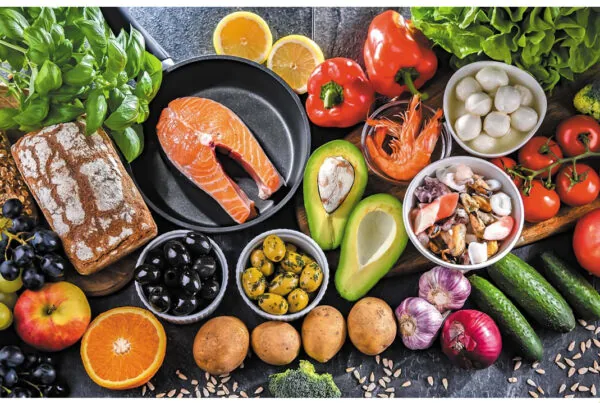Achieving successful weight loss requires understanding one’s own body and its organs. Therefore, it’s crucial to develop a personalized and adaptable nutrition plan tailored to the individual’s lifestyle, taking a holistic approach into account.
“Getting fit” involves a combination of exercise, nutrition, hydration, and rest to repeat everything consistently.
Eating Pattern that fits your metabolism
Let’s start by understanding the meaning of DIET. Diet does NOT necessarily imply the restriction of calorie intake. “In nutrition, diet is the sum of food consumed by a person or other organism”. It could be for purposes such as losing or gaining weight,or restricting certain types of food for medical reasons. Therefore, when we see the word of “diet”, we shouldn’t always assume it implies a strict calorie-controlled food plan.
Finding a eating pattern that fits your body involves understanding your nutritional needs, preferences, and lifestyle.
- Assess Your Goals and Needs: Determine what you want to achieve with your diet. Are you aiming to lose weight, gain muscle, improve overall health, or manage a specific health condition? Understanding your goals will help you narrow down your options
- Consider Your Preferences: Consider your food preferences, cultural background, and dietary restrictions.
- Experiment with Different Approaches: Try out different diet styles to see how your body responds. Such as: low carb high protein, low carb&low protein high plant-based fat, moderate carb&protein&fat. Pay attention to how you feel physically, mentally, and emotionally on each plan.
- Listen to Your Body: Tune in to your body’s signals to determine what works best for you. Take notes, notice how certain foods make you feel and how different eating patterns affect your energy levels, mood, and digestion.
Food Sensitivity
These days, whether due to the environmental factors, soil quality, or new farming trends; many of us experience digestive issues. Therefore, I suggest investing in a food intolerance test before trying to determine the best eating pattern that suits your body and lifestyle. You may think that you’re doing everything right –count your calories, drink enough water, apply a physical activity at least 2-3 times a week, pay attention the times you eat– yet still struggle to lose weight. In such cases, it’s possible that something we eat is causing inflammation which in turn could lead to metabolic issues.
After eliminating certain foods that your body may react to, we can now begin planning the meal schedule
Meal Schedule
To maintain stable blood sugar and insulin levels, it’s recommended to observe a 4-hour (approx.) gap between main meals. This interval allows our bodies to return to normal ranges after consuming any significant meals, potentially reducing the risk of insulin resistance.
Moreover, recent studies suggest that providing adequate recovery time to our gastrointestinal system supports its renewal process. Therefore, it’s advisable to avoid constant snacking, as it may disrupt blood sugar regulation and may lead to unnecessary calorie intake.
What Should We Eat?
Fuel your body with nutritious foods, including lean proteins, whole grains, vegetables, fruits, and healthy fats.
We should stay away from diets that focus solely on ONE food group or item such as zucchini or watermelon diet which is often talked about during summer months. Instead, it’s crucial to prioritize daily nutritional diversity, ensuring that we meet our body’s requirements for all macro and micronutrients. Remember, your body operates as a continuous machine that is active 24/7. First, give your body it’s fuel!
Tips & Tricks
Try starting your meals with low-calorie, high-density options such as salads and soups. This can help you feel full more quickly.
Read the Labels
It’s essential to avoid excessive consumption of processed foods, sugary snacks, and high-calorie beverages. Nowadays, we have access to a variety of packaged foods from different brands, each with its own content. These often contain hidden calories, low-quality vegetable oils cooked using unhealthy methods, and chemicals added for shelf life. Therefore, one of the most important steps is learning how to read food labels.
Potion Control
Be mindful of portion sizes to prevent overeating. Use smaller plates and bowls to help control portion sizes and avoid mindless eating.
Take your time while eating your meal. The slower you eat, the faster you feel full. This helps prevent overeating and promote consuming tolerable portions.
Drink Water
Whenever you feel hungry, ALWAYS drink water first. Don’t forget that you might be just thirsty.
Tips & Tricks
Let me share a small trick with you:
You can calculate the minimum amount of water you need daily using this formula
Your weight (in kilograms) x 30= Your MINIMUM water need (in milliliters-mL)
Anything below this amount, you will have a hard time losing fat mass.
Remember:
1 kilogram(kg) is equal to 2.2 lb. or 1 lb. is equal to 0.45 kg
1 milliliter(mL) is equal to 0.034 fluid oz.
Stay Active
To regulate your hormones and achieve better metabolic outcomes, it’s important to be physically active every day. If nothing else, aim for a 20 to 30-minute walk. This simple activity can have a significant impact on your metabolism, helping you have a better muscle foundation and maintain hormonal balance. Regular physical activity not only supports weight management but also improves overall health and well-being.
Thank you for reading!
Keep it healthy!
Busé



